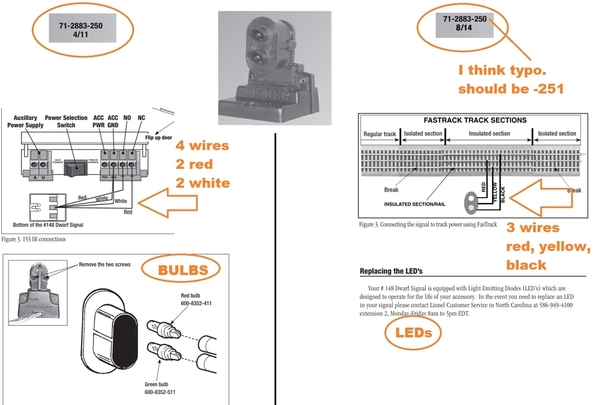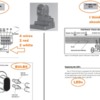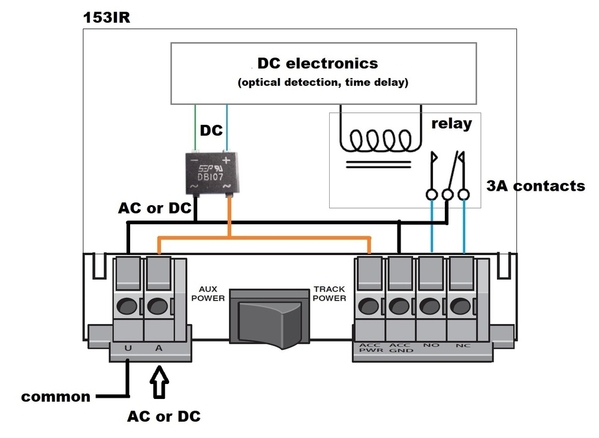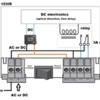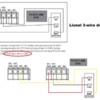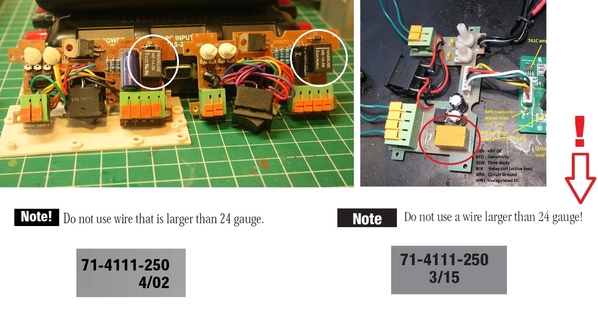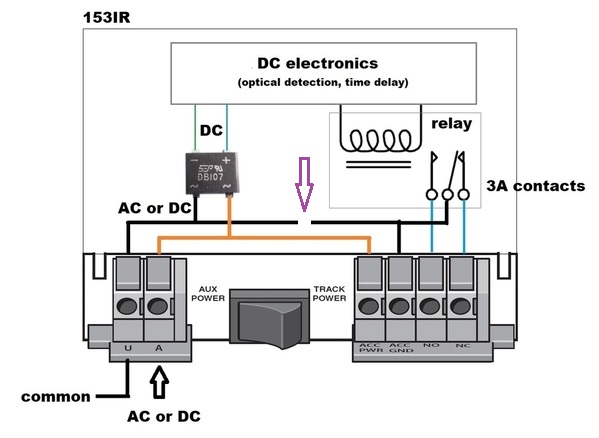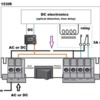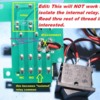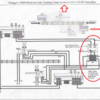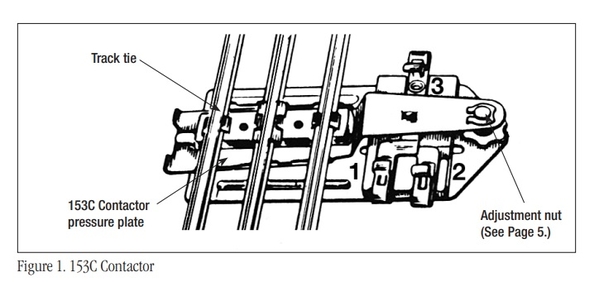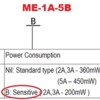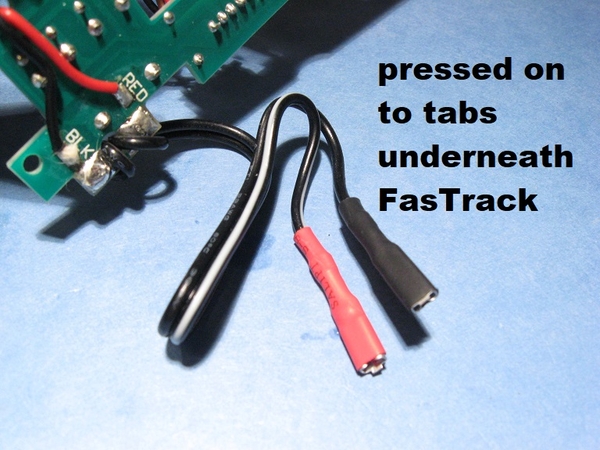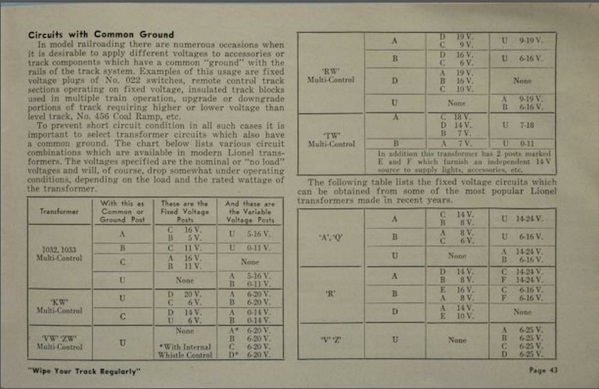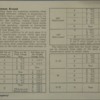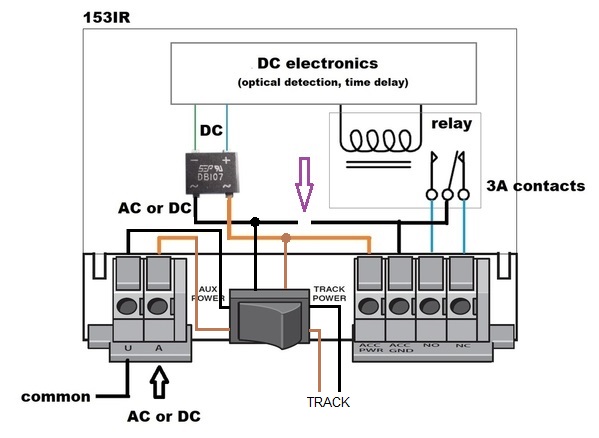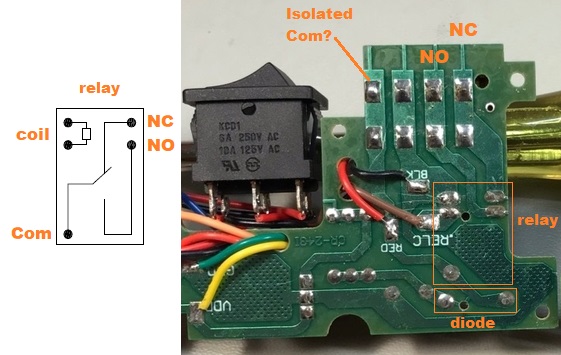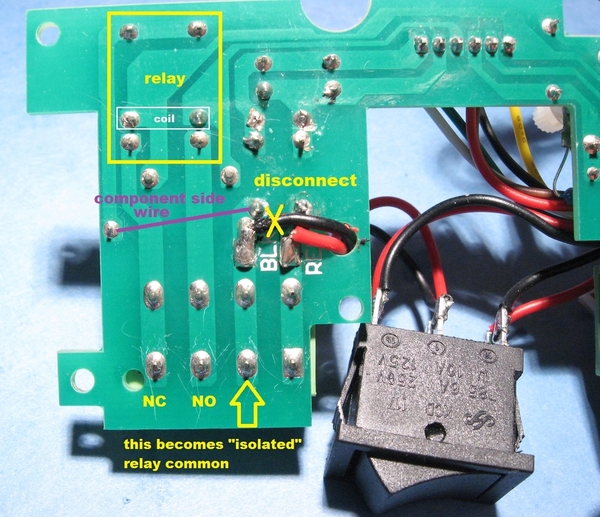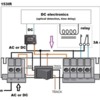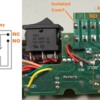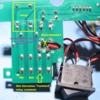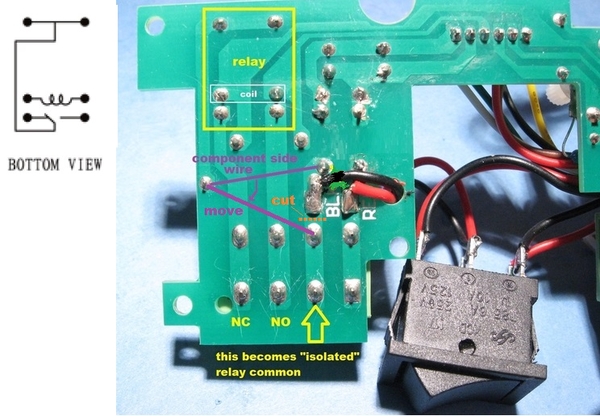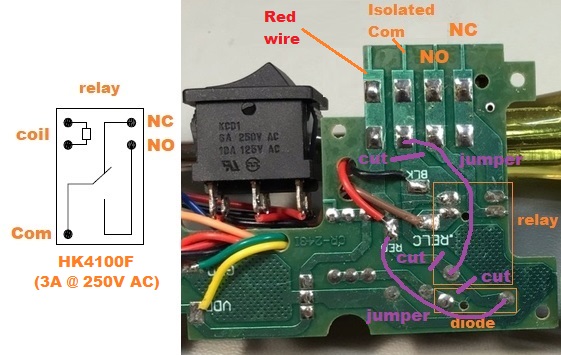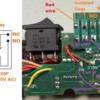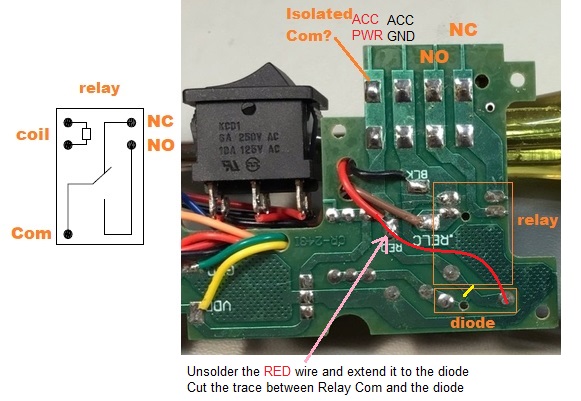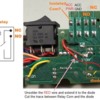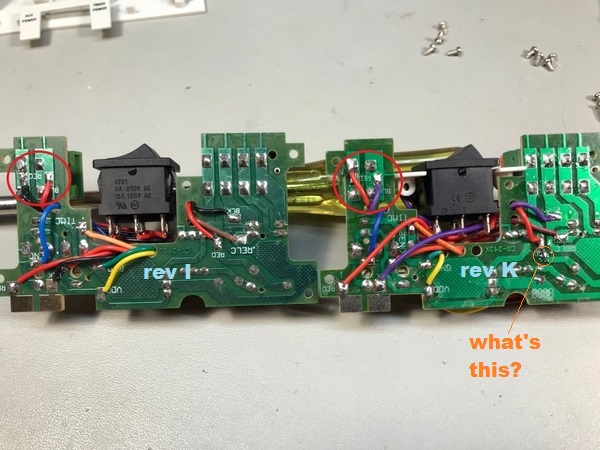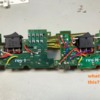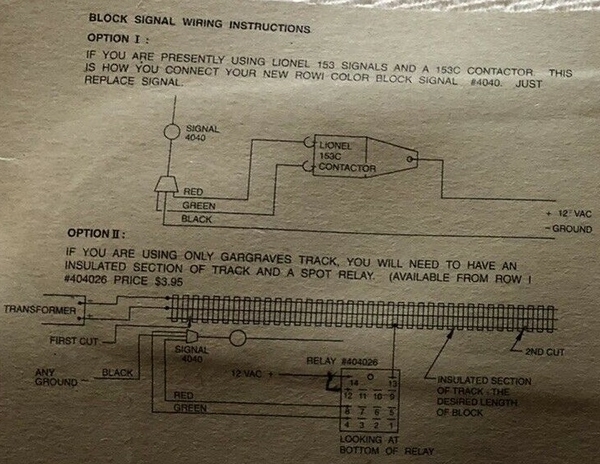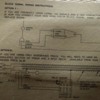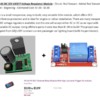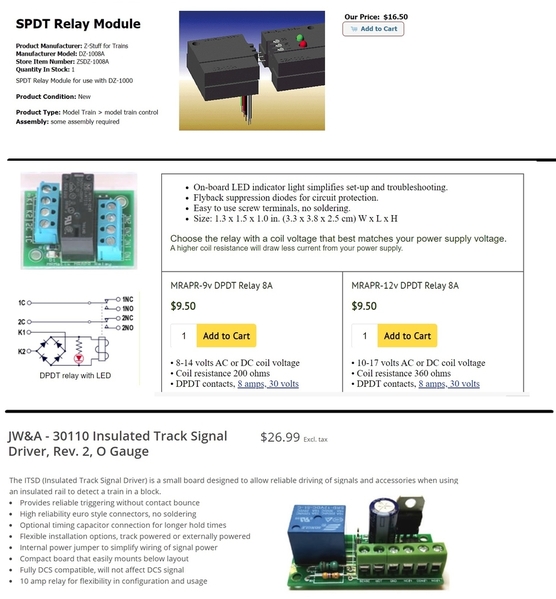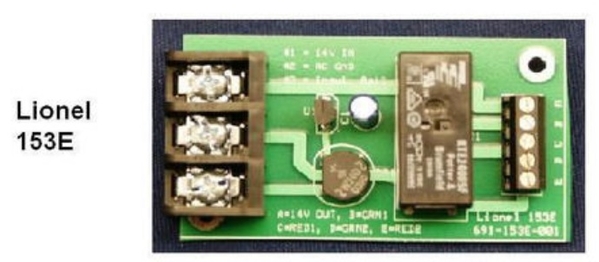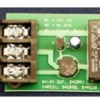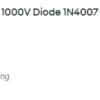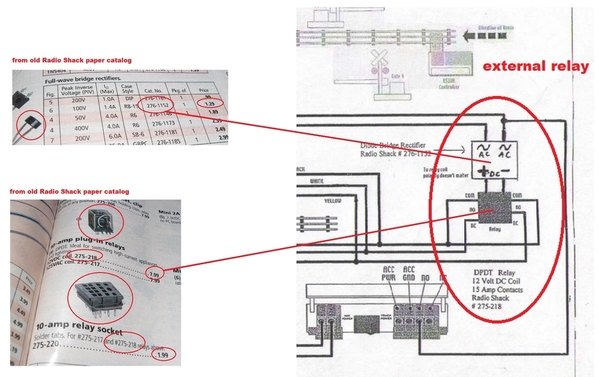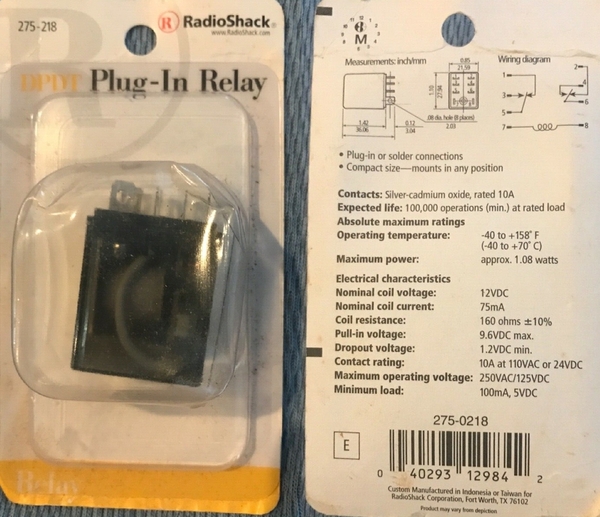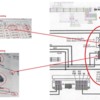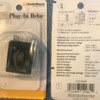I would like to wire (1) dwarf signal to a pair of 153IR's that will be located on my main line approximately 30 feet from each other using track power. The dwarf signal will be located at the exit/entrance of the yard. Is it possible to wire the (2) 153IR's to just a single signal? If a train passes by one sensor and crosses the next sensor before timing out will it damage the signal or 153IR's? I was hoping not to have to install a relay if possible.
Replies sorted oldest to newest
Exactly which dwarf signal do you have?
Right. This is a classic conundrum. The 148 has two inputs - green and red. The 153IR has two outputs - green and red. If you have two 153IR's what happens if they send conflicting commands.
How are you powering the 153IRs and 148s?
Do you have some spare 148 bulbs lying around?
Attachments
I plan on using track power. I have some universal Evans bulbs laying around.
I may be getting ahead of myself. Which version of the 148 do you have?
I don't have a 148. As contrasted above using the miracle of cut-and-paste, Lionel has (at least) 2 versions of the 148. The -250 version is older (2011) and has incandescent bulbs for the lamps. The -251 version is newer (2014) and has LEDs for the lamps. Presumably you've turned them on and might recognize an incandescent bulb vs. an LED...or it appears from the manuals that you can distinguish by whether there are 4 wires or 3 wires coming out the signal.
Attachments
I have the older version with the incandescent bulbs. If I can find the newer (or another "LED" brand) ones I will order them since they are cooler and draw less power.
I like your thinking.
So if you have the newer LED version, life becomes so much simpler. That is, the LED version has only a single input to flip the signal to red (whereas the bulb version has dual inputs).
With a single input, you can simply tie together the two "N.O." outputs of your two 153IR's and the signal will flip to red when either OR both of the 153IR's is triggered. The "N.C." outputs of the 153IR's are not used. There is NO electrical "conflict" if the 2 153IR's disagree on occupancy.
For background, where I was going if you had the incandescent bulb version is as follows. There is a "trick" where you can use some spare incandescent bulbs (but not the Evans universal bulbs) to convert the 2-input signal into a 1-input signal. It has its limitations but does work and has been around for decades.
I am happy that you see the wisdom of going to the low-power LED version even if not realizing how this makes it so much easier to apply with dual 153IR's.
Stan is correct, i have 4 that control two crossing gates. Just a word of caution, there are two of the 153s out there, not including the new one. They need to be wired differently. Stan helped me with a diagram of the difference.
Stan,
I was searching for a diagram of the newer LED version but I can't seem to find one. The older incandescent version that I have has 4 wires. Does the newer version have only 2 wires?
@Tony H posted:Stan is correct, i have 4 that control two crossing gates. Just a word of caution, there are two of the 153s out there, not including the new one. They need to be wired differently. Stan helped me with a diagram of the difference.
Tony,
What is the difference between the 3 models?
I can’t speak of the new one, but here is a post that shows the difference on the two older ones.
Tony,
I will have to see what version I have. I do know they are more than 5 years old, probably closer to 10 years old not positive though.
@R Whitley posted:Stan,
I was searching for a diagram of the newer LED version but I can't seem to find one. The older incandescent version that I have has 4 wires. Does the newer version have only 2 wires?
From what I can tell, the LED version has 3 wires. See the right side of the most recent diagram above. On the Lionel website for the same SKU/model # there are 2 different "reference numbers". Of course you order an item by the SKU number and I don't think you can specify the reference number.
I don't know how the following photo is rendered on your screen but the following is an LED version which is what you want (it has the 3 wire connection). From what I can tell, the LED version will have a yellowish tint to the green lamp. It appears Lionel did not use a pure/deep green as you might be familiar with from a traditional green bulb. Yeah, it's nit-picking on my part and OK I need to "get a life" but the pure/deep green LEDs are just a couple pennies more.
So I guess if ordering from a distributor you can ask how many wires are there...or if the Reference number with the -251 suffix is on the box or whatever.
What Tony is referring to is a separate rabbit hole! Lionel did the same thing with the 153IR. There are (at least) two versions of the 153IR that have different wiring instructions! Yet, the different versions have the same SKU/model number...and most confusingly the same reference number! OK, I get this is a first-world-problem but still....![]()
I was figuring we can solve the 148 "problem" first. The 148 variations on a theme are new to me and I'm learning along with all you guys! OTOH I've been to the 153IR rodeo so I figure I can deal with that when the time comes. ![]()
Attachments
Stan,
I really thank you for all your help (and Tony) that's what I love about this forum, the kind folks, the knowledgeable folks and the willingness to help one another.
I do have one more question, that is where do the 3 wires land on the 153IR? I tried to open the manual on Lionel's site but could not for some reason.
I attached 3 PDF files of 3 "different" 153IR versions I just pulled off the Lionel site...from 2002, 2014, and 2015. IIRC the best way to determine which version of the 153IR you have is to look at the power input terminals on the left and note the orientation of U and A.
OTOH it appears the best way to determine which version of the 148 you have is to see if there are 3 or 4 wires (?) ![]()
Attachments
Correct. If you have the 3-wire version of the 148 with the single-wire trigger, you can have an unlimited number of 153IRs. If just one, any combination, or all of the 153IR's are triggered it will flip the dwarf to red.
Reading between the lines, it might take an experiment or two but even if you have a mix of different 153IR versions I believe it is still possible.
I will let you know how it turns out after my order comes in.
Thanks again!
Well in case it helps the attached .pdf circuit shows how I wired a pair of 153IR's back in 2008. This has worked flawlessly ever since. I apologize that it's hand drawn, but I think its easy enough to follow. This setup services two road crossings that are several feet apart on the same mainline track. One 135IR is to the left of the crossings; the other to the right. You will note there is a pair of ROWI 4 light cantilever signals, and a pair of RK 4 light crossbuck signals. Many other signal variations are possible.
The key thing to note is the 153IR's are wired parallel with respect to the relay Gnd, NC and NO connections. So they operate as two separate SPDT switches. When either one triggers, the NO contacts are grounded, and all signals at both crossings operate in unison. This same idea could be extended to one or two more 153IR's (connected the same way) on converging switch tracks say, or whatever. A key thing to know about the 153IR is that the relay is only rated at 2 amps. This is fine for any number of led devices, or a few incandescents, but no good for something like the gateman for instance. For any heavy load accessories you would want to use the 153IR's to activate a relay, which in turn operates the accessory. ![]()
Rod
Attachments
Rod,
Thanks for the drawing I appreciate that very much! In your example I see you are using a external power source, will this work with track power if the devices will handle the current?
@R Whitley posted:Rod,
Thanks for the drawing I appreciate that very much! In your example I see you are using a external power source, will this work with track power if the devices will handle the current?
I have never tried running them off track power but I suppose you could. I always use accessory power sources for anything other than running trains. Why wouldn't you use the accessory power tap from whatever transformer you are using?? ![]() Also I don't follow what you mean by ".....if the devices will handle the current?" What current do you mean? A device will only pull whatever current from the source that it needs to operate. That current is unrelated to the current that your trains need to operate. And the 153IR relays are only good for max 2 amps. What are you trying to actuate with your 153IR's?
Also I don't follow what you mean by ".....if the devices will handle the current?" What current do you mean? A device will only pull whatever current from the source that it needs to operate. That current is unrelated to the current that your trains need to operate. And the 153IR relays are only good for max 2 amps. What are you trying to actuate with your 153IR's?
Rod
My apologies, I went back in the thread and I see you want to operate a dwarf led signal. So the 2 amp relay rating will be way more than you need. All good.
I should also point out that the 153IRs I am using are first generation 2002, so the connections for yours may be different. Regardless, the concept is the same, wire the relay connectons in parrallel between the two 153IRs and all should be well in the kingdom. ![]()
Rod
@R Whitley posted:Stan,
I have some Lionel #148 Dwarf Signals 6-12883 laying around. I'm open to changing to something that may work better.
Not sure if this would work for you, but here's a simple schematic using a Z-Stuff block signal detector and relay to an MTH dwarf signal.

In the previous thread, that Tony H referenced, it looks like Stan has opened one of these up. I am curious about the internal connections, especially for the relay.
Dave
I made the above diagram for the 153IR I dis-assembled. I have yet to find a definitive marking, stamp, labeling, or whatever to know for certain which version I had. Perhaps obvious when drawn out, but the key is the two power inputs (whether from track power or Aux power) are wired over to the 4 terminals that go to the accessory; and that one of the two power wires is internally wired to the common of the relay.
In the latest online 153IR manual the diagram for the Lionel Dwarf is as shown:
Note how the caption specifically mentions "2014" suggesting there are other versions of the 148 dwarf that would be wired differently! To be absolutely clear this diagram is for the LIONEL 3-wire dwarf. The earlier post by Richie C shows a MTH 3-wire dwarf. THEY ARE NOT WIRED THE SAME WAY. As his diagram shows the MTH 3-wire dwarf requires a RELAY.
In any case, getting back to the original problem. Once the LIONEL 3-wire dwarfs are in hand, it won't take long to sort out versions of the 153IR. It will be handy to have a multimeter that measures Ohms (resistance).
Then, connecting the 2nd 153IR to work in tandem will be as simple as connecting 1 wire between the N.O. terminals of the 2 153IRs! Life should be so easy! ![]()
Attachments
Stan, perhaps I should have been a bit more clear. I was asking about the actual connections for the relay, whether it is soldered directly to the board, or wired like the toggle switch appears to be in your pictures from the other thread.
Dave
@Dtrainmaster posted:Stan, perhaps I should have been a bit more clear. I was asking about the actual connections for the relay, whether it is soldered directly to the board, or wired like the toggle switch appears to be in your pictures from the other thread.
Soldered directly to the single-side PCB with thru-hole relay terminals. I found this photo showing 2 versions of the 153IR which I must have posted in a previous OGR thread but can't remember the context - probably a discussion about how to replace a potentially broken relay or something like that.
Attachments
Thanks Stan. Do you think that the connection or trace between the relay's common terminal and either the A or U terminal (depending on the version) can be easily accessed and opened?
Attachments
Edit: this will NOT work; a different solution shown later in thread. I leave the photo and comments for continuity of discussion...
In the above case all you'd have to do is de-solder the black wire where shown. Then, the left 3 (per photo above) externally accessible terminals on the 153IR would be "relay NC" "relay NO" and "relay COM" and you would be free to have the relay control whatever you want!
I don't know how many variants of the 153IR PCB there are, but I suspect that in some variants you might have to cut a fat PCB trace with an X-acto knife to break the connection between the internal relay's "common" and train power. But in any case I think you could always end up with 3 terminals that represent completely "isolated" NC-NO-COM so you are electrically divorced from only controlling train power.
Great question!!! ![]()
Attachments
Thanks Stan for checking the board. That's what I was hoping for, an easy alteration for most.
I have an application drawing made but need to finalize a few things on it.
Dave
@Dtrainmaster posted:153 IR modification
...
This modification enables 2-aspect signals to change from GRN to RED whenever any detector in the string is triggered....
Perhaps just a note to myself for when I stumble on this thread in the future...but what Dtrainmaster is showing is a method to drive the 4-wire 148 dwarf signal. Yes, it does require mucking around inside the 153IR which is not in most folks' comfort zone. And without getting into the details, I did study some photos of earlier versions of the 153IR and the mucking around is a bit more involved.
Also this modification can be used to good effect for two (or more) 153IRs controlling the 5-wire crossing gates (Lionel or MTH). If using two Lionel 153IRs or two MTH ITADs to control the 5-wire crossing gate, you need an external relay. For example, Lionel has a somewhat complicated diagram showing how to wire the external relay. Arguably, by the time you procure parts, pull hair out trying to follow the Lionel diagram, etc. what Dtrainmaster shows is the superior solution! No external relay required! Zero out-of-pocket expense! Wow, I could have had a V8! ![]()
Attachments
Seems a lot of work to avoid a simple relay...
Nothing is so easy as the job you imagine someone else doing!
1. Lionel's diagram suggests Radio Shack components. In 2021 how many guys have access to Radio Shack - even the re-incarnated Hobby Lobby variant?
2. The suggested bridge-rectifier is not even sold at RadioShack.com...and how many guys are comfortable choosing an alternative based on techno-mumbo-jumbo specifications?
3. The suggested relay IS still available at RadioShack but is a whopping $14.99...and you still need to buy a relay socket or solder to the spade-lugs. Again, how many guys are comfortable choosing an alternative...is it a problem that the Lionel diagram says 15 Amp contacts, but the Radio Shack listing says that part number has 10 Amp contacts? And aren't these Amp ratings a bit over the top for the application at hand?
4. Then you look at the Lionel diagram and see a box representing a relay with 6 terminals labeled COM NO NC twice over. I don't know what the package on the Radio Shack relay looks like, but how many guys know that a dual-pole relay has separate COM NO and NC for each pole. Which COM to use? Can either NO be used? I don't think it's obvious how to hook up the terminals of the relay just looking at the diagram.
5. And so on. ![]()
OTOH, the out-of-pocket cost for the workaround is $0 (as in zero). In the case of the modern 153IR the modification does not even require a soldering iron! Just clip 1 wire. Yes, you do have to remove some screws to open up the 153IR so there is that.
I'm just thankful for OGR that we have a venue to have these discussions! 
@stan2004 posted:I made the above diagram for the 153IR I dis-assembled. I have yet to find a definitive marking, stamp, labeling, or whatever to know for certain which version I had. Perhaps obvious when drawn out, but the key is the two power inputs (whether from track power or Aux power) are wired over to the 4 terminals that go to the accessory; and that one of the two power wires is internally wired to the common of the relay.
In the latest online 153IR manual the diagram for the Lionel Dwarf is as shown:
Note how the caption specifically mentions "2014" suggesting there are other versions of the 148 dwarf that would be wired differently! To be absolutely clear this diagram is for the LIONEL 3-wire dwarf. The earlier post by Richie C shows a MTH 3-wire dwarf. THEY ARE NOT WIRED THE SAME WAY. As his diagram shows the MTH 3-wire dwarf requires a RELAY.
In any case, getting back to the original problem. Once the LIONEL 3-wire dwarfs are in hand, it won't take long to sort out versions of the 153IR. It will be handy to have a multimeter that measures Ohms (resistance).
Then, connecting the 2nd 153IR to work in tandem will be as simple as connecting 1 wire between the N.O. terminals of the 2 153IRs! Life should be so easy!
Stan, I just received my 3 wire LED Lionel dwarfs 6-12883 from Charles Ro and by the way they are great folks to deal with. With the diagram above I wired (4) 153IR's with the jumper going in and out on the N/O contacts. I just had (1) dwarf wired to (1) 153IR and a jumper leaving that one and in and out on the next (3) 153IR's. Worked Great!
I happen to have a police vehicle with LED's attached to the 4th 153IR on N/O contacts and those lights also operated when I tripped any one of the 153IR's.
I didn't try to put the car on the N/C contacts, I wonder if the jumper going to the N/O contacts would change that to N/O or would it effect that function at all. What's your thoughts on that?
Mission Accomplished!
@R Whitley posted:Stan, I just received my 3 wire LED Lionel dwarfs 6-12883 from Charles Ro and by the way they are great folks to deal with. With the diagram above I wired (4) 153IR's with the jumper going in and out on the N/O contacts. I just had (1) dwarf wired to (1) 153IR and a jumper leaving that one and in and out on the next (3) 153IR's. Worked Great!
I happen to have a police vehicle with LED's attached to the 4th 153IR on N/O contacts and those lights also operated when I tripped any one of the 153IR's.
I didn't try to put the car on the N/C contacts, I wonder if the jumper going to the N/O contacts would change that to N/O or would it effect that function at all. What's your thoughts on that?
Mission Accomplished!
wow, that was fast. ![]()
Summarizing: you have 4 153IRs. The N/O contacts on all 4 are connected/daisy-chained together. The police car is connected to this "communal" N/O bus and the police car operates whenever one (or more) 153IR trips.
The N/C contacts on the 4 153IRs are presently un-connected. If you connect the police car to the N/C of one of the 4, the police lights will normally be ON, and turn OFF when that particular 153IR is tripped. Not sure if you're asking about daisy-chaining the N/C terminals from ALL of the 4 153IRs? I don't think that would be a useful configuration. That is, in such a case the police car would only turn OFF when all 4 of the 153IRs are tripped which one would think would be a once-in-a-blue-moon occurrence?
@stan2004 posted:wow, that was fast.
Summarizing: you have 4 153IRs. The N/O contacts on all 4 are connected/daisy-chained together. The police car is connected to this "communal" N/O bus and the police car operates whenever one (or more) 153IR trips.
The N/C contacts on the 4 153IRs are presently un-connected. If you connect the police car to the N/C of one of the 4, the police lights will normally be ON, and turn OFF when that particular 153IR is tripped. Not sure if you're asking about daisy-chaining the N/C terminals from ALL of the 4 153IRs? I don't think that would be a useful configuration. That is, in such a case the police car would only turn OFF when all 4 of the 153IRs are tripped which one would think would be a once-in-a-blue-moon occurrence?
Stan, I don't want to daisy chain the N/C, but I would like to keep the police car tied into that one 153IR. I may even tie something else to the other (3) 153IR's like other cars or some other low amperage draw accessories. So, does that daisy chain connection affect both the N/O and N/C on all the 153IR's contacts when anyone of the 4 are tripped?
The daisy-chain does NOT decrease the amperage capability. This applies to N/O and/or N/C. So you can daisy-chain all the N/O without affecting the N/C (4 isolated N/C or all 4 daisy-chained).
Lionel has changed the relay used in the 153IR over time, but I noted in an earlier diagram that the contacts on a modern 153IR are rated at 3 Amps. I'd have to check but even the earliest versions had contacts of at least 1 Amp. Your 3-wire Lionel dwarf LED signal requires not even 1% of that capability!
Let there be light!
If I'm understanding you correctly, I can put another dwarf signal or another device on any one of the other units that are daisy chained on the N/C contacts and that 153IR would operate totally independent of the other ones?
@R Whitley posted:If I'm understanding you correctly, I can put another dwarf signal or another device on any one of the other units that are daisy chained on the N/C contacts and that 153IR would operate totally independent of the other ones?
To be clear, your 4 units are daisy-chained on the N/O contacts...and now you are putting another dwarf signal or another device on the N/C contact of 1 of the 4 153IRs?
The 3-wire Lionel LED dwarf operates backwards if connected to the N/C contact of 1 of 4 the 153IRs. So signal will be RED when un-occupied...and turn GREEN when occupied (tripped). Or if the device is a lighted police car, as mentioned above, it would be ON when that particular 153IR is un-occupied and turn OFF when that 153IR is occupied (tripped).
I guess it's a question of semantics to say "that" 153IR operates totally independent. Since its N/O contact is still daisy-chained to the other 153IRs, it (or any of the other 3) will turn the original dwarf RED when it (or any of the other 3) is tripped.
Thank you Stan and all the others who have contributed to this topic! ![]()
Stan, if you are still following this thread, here is the pdf of the manual for the first version of the 153IR that I bought, dated 1/01. I scanned the cover for it plus the cover of the later version dated 11/02 just for comparison. But the manual page by page scan is for the earlier 1/01 version.
Rod
Attachments
Attached is a video clip showing the crossing signals controlled by the two tandem 153IR's in action. As described a few posts earlier in this thread. Please don't be too harsh about my somewhat crude attempts at sceniccing; it's not my strong suit for sure! ![]()
Rod
Attachments
Thanks Rod! ![]() Slowly but surely the pieces to the puzzle are coming together.
Slowly but surely the pieces to the puzzle are coming together.
Some interesting tidbits from your 1-2001 manual:
1. A degree in Nuclear Physics will be helpful to understanding how to hookup the 153IR. ![]()
2. When you first turn on this version, both the NO and NC turn on for 3 seconds...at the same time. Does anyone following along recognize this behavior? This suggests this version does NOT use a relay inside. Can you hear the tell-tale relay "click" sound when triggering? For example they could have used triacs to turn on both NO and NC at the same time. Point being this would restrict this version to AC-only operation. I'll need to make a mental note as the more recent 153IR versions can be DC-powered which can be useful in some applications.
3. And now I see what others have mentioned in passing about the lack of marking on the power inputs. The manual essentially says polarity is irrelevant since this is AC. This can/will be a problem for applications that use more than one 153IR such as the topic of this thread! The use of the terminology COM1 and COM2 to refer to the two AC power signals is an accident waiting to happen. ![]()
4. I did not see or might have missed any reference to the behavior of the 153IR turning off by itself if the trigger persists. I was not clear if this was ever a designed-in behavior or a known error in some batch of units or ???. I can imagine there might be an application where you want an accessory to turn OFF (so as not to overheat for example) if the train stops in front of the 153IR for an extended period.
Attachments
Stan I dont use this /01 one version on my layout anymore. I think it is safely stored away in its box, so I can't readily locate it to test your questions out. I replaced it early on with a pair of the /02 versions, which don't timeout if the train stops in front of the controller. The one I opened up years ago was the latter /02 version and it for sure uses a smallish 2 amp spdt relay. I'll see if I can find any pictures of the innards.
I agree with your concern regarding extended activation of some accessories. It's a case of user beware (and sensible) I guess!
Rod
I have photos of the innards of at least 2 earlier versions courtesy of member Charly from about 5 years ago. In this OGR thread we were trying to troubleshoot an apparently "stuck-ON" relay. Both the versions shown used relays. Unfortunately, I don't see any notes correlating the 153IR revision date with the photos or markings on the boards or enclosures.
I realize it's boxed up, but the version I'm most curious about is the 2001 which I'm thinking might have used triacs instead of a relay. I think it interesting that some engineer chose to simultaneously power both NO and NC for 3 seconds as a power-on self-check.
If this were the case (triacs instead of relay), opening one of these early 153IR versions to make dtrainmaster's modification to isolate the outputs from the power will not find much joy. ![]()
I may get ambitious Stan and see if I can find my early 153IR. I am fairly sure its around here somewhere, but I am also sure I have not laid eyes on it in at least 15 years? ![]()
Rod
OK so I got curious and had a look. Guess what; all 153IR boxes were right where they should have been, right in a large box marked controllers/signals. Love it when stuff is where it should be. ![]() Here is a pic of a 2002 version, still in it's box:
Here is a pic of a 2002 version, still in it's box:
No surprises here, terminals are marked as expected for the second run version.
Then I had a look at the two units that I have on the layout. They are both the same and here is what they look like:
I believe this layout jives with the 2001 manual that I scanned above. So it looks like they are the first run originals, and my plan was to change them out to the 2002 version, but (can you believe it?) I never got around to it! My bad. I didn't feel like taking one of these apart to see if it has a relay or triacs, but guess what? When activated, and again when it times out, there is the unmistakeable click of relay activation. So they are relay operation for sure.
So then I tested what happens if a train stops in front of one. As expected for the first run, the sensor times out and the crossing signals all cease functioning. So I guess I either have never noticed this happen, or just said who cares?
One bonus to all this is I found several other interesting things in said box, that I forgot I even had. Just like Christmas morning! ![]()
Rod
Attachments
@Rod Stewart posted:I believe this layout jives with the 2001 manual that I scanned above. So it looks like they are the first run originals, and my plan was to change them out to the 2002 version, but (can you believe it?) I never got around to it! My bad. I didn't feel like taking one of these apart to see if it has a relay or triacs, but guess what? When activated, and again when it times out, there is the unmistakeable click of relay activation. So they are relay operation for sure.
So then I tested what happens if a train stops in front of one. As expected for the first run, the sensor times out and the crossing signals all cease functioning. So I guess I either have never noticed this happen, or just said who cares?
...
So it appears in your photo above that you have a signal connected to both the NO and NC terminals of this first run original. So presumably NO lights Red, and NC lights Green? Per the manual you scanned/posted, both NO and NC terminals are simultaneously activated for 3 seconds as a power-on self-test. Does this happen? I'm baffled how they do this if you're hearing a relay-like "click" when it's triggered!
Yes, I realize they could be using two SPST relays (instead of 1 SPDT relay) but I find this hard to believe. Now I'm really confused!
Hah Stan, you think you're confused? Welcome to my world. I can't comment as to whether both NC and NO are activated for the first 3 seconds after power up or not. I may have to test that out next.
I am surprised no one asked why the two NC connections are wired together in my sketch posted earlier. They don't connect to anything except each of the 153IR NC connections. My plan was to possibly use the NC connections for green block signals as you suggest. But currently only the NO contacts do anything, and they only actuate the 4 different led road crossing signals at the two road crossings you see in the video posted earlier. Often when wiring things up I will run spare wires that may get used in the future, because it is no more difficult at the time of installation, but a real PITA to come back and add later. Often I just bring them to a terminal block and terminate them there. ![]()
Rod
OK. I get it. Yes, your diagram earlier showed you were only using 2-wire signals which means connecting the NC outputs of multiple 153IRs is benign.
So then the question is does the first-version 153IR turn Red (i.e., activate or flash) for 3 seconds when you first apply power? And since you apparently have more modern versions on the layout, do any of them momentarily activate the Red (NO) output on powerup?
Stan, to your 1st question "......does the first-version 153IR turn Red (i.e., activate or flash) for 3 seconds when you first apply power? "
Answer: When these are first powered up the relay closes the NO contacts, so all crossing signals operate for the full length of the delay setting; much longer than 3 seconds. Put another way, it's as if the signal has been triggered by a passing train. This happens with every power up cycle.
To your 2nd question " And since you apparently have more modern versions on the layout, do any of them momentarily activate the Red (NO) output on powerup?"
Answer: I don't actually have either of the newer 2002's on the layout. They are in their boxes. I may bench test one of them to find out, but I am quite doubtful since the manual for them makes no reference to that. I suspect they operate as above.
Rod
Stan, I think you're missing one thing. The manual's text said triggered for 3 seconds. I took this as meaning the NO and NC outputs switched as they should.
Edit: I read it again, now I'm not sure - it is saying both things.
-------------------
I've made an additional 153 IR application sheet with two more diagrams. One diagram shows a different connection scheme for the C-to-ACC GND version shown on my first sheet. The other diagram is for the version in the 71-4111-250 1/01 manual.
But I need some additional information, taken directly from a functioning unit of this type, before finalizing it. If Rod could oblige us and check a few things it would help.
Dave
Dave what did you have in mind?
Rod
Rod, here's what I need. With the 153 IR powered ON, not triggered, and nothing connected to it except the AC input to the Power Supply terminals, what do you measure in relation to the following:
1) between COM 1 and COM 2, AC or DC ?
2) voltage between NC and COM 1 ?
3) voltage between COM 2 and the left Power Supply terminal ? (if AC from test 1)
4) voltage between COM 2 and the right Power Supply terminal ? (if AC from test 1)
Depending on the readings you get, there may be additional questions.
Dave
I need to go out for awhile, will check back later.
OK Dave; got some numbers for you.
First, my supply voltage is 14.3 VAC. Also be aware that these tests were done with Com1, NC and NO connected per my earlier wiring diagram. But measurements were done after the timeout; ie there was no load and the NO contacts were open.
1) between COM 1 and COM 2, AC or DC ? 14.3 VAC
2) voltage between NC and COM 1 ? 14.3 VAC
3) voltage between COM 2 and the left Power Supply terminal ? (if AC from test 1) 0.0 VAC
4) voltage between COM 2 and the right Power Supply terminal ? (if AC from test 1) 14.3 VAC
So it appears that Com2 and the left power terminal are internally connected.
Hope this helps, Rod
Is it practical for you to measure the AC voltage between COM1 and NC for the few seconds when you FIRST turn on power? I'm back on the notion that this first version of the 153IR applies power to NO and NC simultaneously for seconds when you first apply power.
Stan, the voltage between Com 1 and NC is 4.90 VAC for the entire 20 seconds or so that the relay is powered (NO closed, as if triggered), then it returns to 14.3 VAC after the relay returns to NC. Nothing discernible happened after the first 3 seconds of power up.
Rod
@Rod Stewart posted:...So it appears that Com2 and the left power terminal are internally connected.
Right... which differs from other versions in terms how the 2 input power wires (on the 2-terminal left block) are routed to the 2 output power wires (left 2 of the 4-terminal right block). ![]()
@Rod Stewart posted:Stan, the voltage between Com 1 and NC is 4.90 VAC for the entire 20 seconds or so that the relay is powered (NO closed, as if triggered), then it returns to 14.3 VAC after the relay returns to NC. Nothing discernible happened after the first 3 seconds of power up.
Oh joy (sarcasm). So it doesn't behave per the manual.
Thanks though for participating in the snipe hunt. ![]()
… You've got to know when to hold 'em
Know when to fold 'em
Know when to walk away
And know when to run…
Kenny Rogers (The Gambler)
I think it's time to RUN! ![]()
Stan, "You can run but you can't hide" ![]()
I may get ambitious and swap in the "newer" 2002 versions in place of the first run 153IR's and see if there is any difference in operation. Might be interesting. I am still waiting on some OshPark pcbs needed for a couple of projects, so messing with these 153IR's will fill in some time.
Rod
@Rod Stewart posted:Stan, the voltage between Com 1 and NC is 4.90 VAC for the entire 20 seconds or so that the relay is powered (NO closed, as if triggered), then it returns to 14.3 VAC after the relay returns to NC. Nothing discernible happened after the first 3 seconds of power up.
Rod
I knew something did not make sense with this 4.9 VAC. So I re-measured this, but this time with the NC disconnected from my wiring, and it came up with 0.3 VAC; call it zero. And it still goes to 14.3 VAC after the delay times out and the relay reverts to NC closed. No difference after or before 3 seconds from power up though.
So the weird voltage was something coming back from the NC connection of the parallel wired 153IR. This wire is not connected to anything else along the way.
Rod
Out of curiosity, about how long is/was the wire going between the NC terminals? And did it run along or nearby any AC wires (whether track power, ACC power, etc.)?
Also, I assume you're using a modern digital multimeter?
Rod, thanks for doing the test, but it really needs to be done with the wires disconnected from the outputs. I am afraid that the NC terminal is being back-fed from those wires, even if not directly connected to something else. You could be getting a voltage reading because of the sensitivity of your meter. Please re-run tests 2, 3, & 4 in that manner, then preform one more step. Swap the two power supply wires and re-run the tests. I am trying to eliminate something here that I don't want to get into if it doesn't exist.
Stan, if you look at the sheet I previously posted, the first diagram shows the ACC PWR terminal (same location as the COM 2 terminal) connected to the A, left power supply terminal. The second diagram shows the ACC GND terminal (same location as the COM 1 terminal) connected to the U, left power supply terminal.
Dave
Looks like you did the first part while I was writing.
I put both the 2001 and 2002 versions side by side on the bench today and did some continuity checking. The attached pdf is marked up to show the internal connections in red. Note the left one is the 2002, and the right one is the first run 2001. Obviously the NC connections are in the non-triggered state only. In both cases when the relay is triggered, the connection to NC is broken, and the connection to NO is made, as expected.
This info may lend to our knowledge base, or not! ![]()
Rod
Attachments
@stan2004 posted:Out of curiosity, about how long is/was the wire going between the NC terminals? And did it run along or nearby any AC wires (whether track power, ACC power, etc.)?
Also, I assume you're using a modern digital multimeter?
Kind of what I was thinking Stan. The white NC interconnect wire certainly does run over/under/beside a vast array of wires enroute between the two 153IR's.
Dave, the info I just posted above may answer what you are curious about. Let me know.
Rod
Rod, your marked-up pg.5 of the 2002 version manual doesn't look correct, in regards to the A-U terminals.
Note the references on these pages.
Are you absolutely sure of the continuity readings for the A and U terminals? According to the text in this manual, when referencing ground, U should go to ACC GND. Are you sure that the version you tested was an A-U version? The version that Stan showed earlier was a U-A.
Dave
Attachments
@Dtrainmaster posted:Rod, your marked-up pg.5 of the 2002 version manual doesn't look correct, in regards to the A-U terminals.
Note the references on these pages.
Are you absolutely sure of the continuity readings for the A and U terminals? According to the text in this manual, when referencing ground, U should go to ACC GND. Are you sure that the version you tested was an A-U version? The version that Stan showed earlier was a U-A.
Dave
Dave, I think the drawing I attached for the '02 unit looks just like the one you have shown above. A on the left, U on the right. What am I missing? Note the date of 4/02 on your page 3 above. My manual is dated 11/02, so I guess it is updated. Maybe your manual is wrong?Why not check your 135IR and see what you find? I believe that the 2015 version has A & U reversed, but I have none newer than 2002.
And U connects to ACC PWR; not ACC Gnd. I can recheck them, but what I show in my earlier post above jives with a continuity check I did some 14 years ago, and I just rechecked it today on the bench. Unless I have one that is internally mis-wired or something weird.
As an aside, it would be really nice if Lionel would settle on ONE design and hookup system for these things someday. Maybe the 2015 version is the final?
Rod
Rod, the manuals I referenced were taken from this thread and the mfg.'s website. I have no units to look at. I think that if Stan or I had the three variations in our possession they would have been opened and dissected by now, along with an internal diagram made. Good catch on the date you pointed out, that was possibly for another change made.
If U (common/ground/U) connects to ACC PWR, then the actual output goes against usual accessory terminal language.
If that is the way that all, or even part, of the A-U variation was made, then the diagram I made is incorrect for those units.
Dave
I hear you Dave. And I agree it's kind of strange that The A terminal connects to ACC Gnd and U connects to ACC Pwr. That flies in the face of Lionel's standard transformer nomenclature for the entire PW period and beyond. But there you have it. I can only report on what I have found. Maybe that's why the A and U posts on the 2015 units are switched? Could it be that simple? If so, why did it take 13 years to do?
What I can say for sure is that today I installed one of the 2002 units on the layout (in place of a 2001 unit), using the internal wiring as I sketched it, and it works exactly as expected. And unlike the 2001 units, it does not power up in triggered mode. It wakes up in non-triggered mode, which I much prefer.
Rod
Here FWIW is a pdf of the 11/02 manual for the 153IR that came with one of the two 2002 units that I have. I believe this supercedes the manual dated 4/02.
Rod
Attachments
Rod, thanks for the help on this wonderful journey. If only we had the ability to travel back in time to Frankenstein's laboratory, we could see how this 153 IR evolved. ![]()
As far as transformer markings go, a postwar ZW shows U as Common, whereas my LWs have A as the Common bus and U as the Variable output.
Dave
Due to the fact that there appear to be several variations of 153 IR controllers, and different instruction manual dates for some versions, along with conflicting terminology, I have decided to pull the (2) application diagrams and corresponding information that I posted earlier. The copy of the pictorial diagram that Stan posted of the unit he opened, and I marked the modification on, has remained.
Although the modification allowing full use of the relay is still able to be preformed, the number of variations involved requires the ability to determine which of the ACC or COM terminals, and which of the Auxiliary Power Supply terminals, are internally connected to Relay Common. This also affects how the outputs correspond to Transformer Common/Track Common/Layout Common Ground.
If at a later date, simple but accurate diagrams, like the one that Stan posted of the unit he opened, are made of at least the 3 known variations (A-U, U-A, Power Supply - for auxiliary input) I will re-post application drawings based on those.
Dave
Yes, hopefully we will get to the point where you'll feel comfortable re-posting your diagram but it is a GOOD IDEA! ![]()
This application comes up like clockwork on OGR...seems more so for the 5-wire crossing gates than the dwarf signal. In other words, 2 153IRs, one on each side of a grade crossing. And in each case the "answer" is the external relay for $10-20 off-the-shelf, or $5-10 if willing to do a little wiring and mess with eBay/Amazon modules, or <$5 if able to solder and work at the component level such as diodes and such. But in the big scheme of things, since the 153IR is $45.99 MSRP, I suppose if you have two of them in the first place, then $10-20 for an external "arbitration" relay (that's what I've called it in OGR threads) is a non-issue to get them to "play-well" with each other! ![]()
The reality though is that the vast majority of OGR readers want a "plug-and-play" solution and very few would have the time to work thru, in this case, determining which version of the 153IR they had...then opening it up, then possibly cutting a PCB trace, and so on.
153IR RESOLUTION; ALL IS NOT LOST!!
Today I put both my 2002 versions on the bench side by side and checked continuity, expecting no surprises. GUESS WHAT; they are not the same. One is wired with the strange A-U to ACC Pwr and ACC Gnd, as posted above, and the other is wired just like both the 2001 versions. So I tore them apart to see what is different, here is what I found. Notice the wiring in the red circles. This is right underneath the power input terminals.
Sure enough the one on the left (the one I first checked) has the red and black wires reversed from the one on the right, and clearly wrong according to the colors silkscreened on the pcb. Obviously a glitch in the assembly process. So the easy fix was to swap the wires on the one on the left, which makes them both the same, and now the continuity checks of both match up with the continuity of the 2001 versions. Yahoo! Consistency is a great thing.
Here is a pic of the board topsides. Even though these two were bought at the same time, from the same supplier, and have manuals both dated 11/02, clearly they are from a different assembly lot. Various wire colors are different, and one pcb is rev CR-243I while the second is CR-243K.
Also worth noting is the relay at the right end of the board is still a 2 amp, same as the first run version. (Corrected)
This picture just shows the different boxes that the two come in. The left is the first run 2001 box, the right is the 2002 version.
So Dave, your wiring is probably correct if you are using internal continuity as I showed for the 2001 version above. All mine are now wired this way.
In summary, despite this little botch up, I still believe the 153IR does a great job for what it is, and I have no issues with them. It was important for me to find out why the two 2002 versions were wired differently, since they operate in tandem on my layout and they have to be talking to each other the same way. The 2002 version of these things has a couple of advantages over the 2001. Namely it powers up in non-triggered mode, and the connector designations make a lot more sense, especially now. ![]() Another nice thing is the 2002 versions stay triggered when a train stops in front of the sensor. The 2001 versions do not.
Another nice thing is the 2002 versions stay triggered when a train stops in front of the sensor. The 2001 versions do not.
Hope this clears the air somewhat on these guys,
Rod
Attachments
I thought I got away from this for awhile, but then....Oh...No!
Now, I don't just think these were born in Frankenstein's Lab, I think that the monster himself was building them!
"...one pcb is rev CR-243I while the second is CR-243K" Let's hope that units 243A to H didn't make it out the castle door. But 243J could be lurking just around that door.
Since both you and Stan have had them open, did either of you trace the connections from the toggle switch to the track tabs for track power. I'm curious about the relationship to the AUX power input. I'd like to find out which side of that input supplies the same polarity as the outer rail. Of course, the wires could be flipped on either side of the connection on different units, here also.
Dave
@Rod Stewart posted:...
Also worth noting is the relay at the right end of the board is now a 1 amp version (on both), whereas the earlier 2001 units were 2A.
Not sure what you mean here. I read the relay markings as ME-1A-5B. From the MASSUSE datasheet:
So those are 2A contacts (and that's at 120VAC)...so conservative if carrying 14V Accessory AC.
Attachments
@Dtrainmaster posted:...
Since both you and Stan have had them open, did either of you trace the connections from the toggle switch to the track tabs for track power. I'm curious about the relationship to the AUX power input. I'd like to find out which side of that input supplies the same polarity as the outer rail. ...
On all the pics, diagrams, drawings I've seen there is a DPDT selector switch which chooses between 2-wire Track Power or 2-wire Accessory Aux Power. In the photo above you can see that the black wires are on the "upper" row (one DPDT pole) and the red wires are on the "lower" row (the other DPDT pole).
So when you ask how the track power "polarity" correlates to the Aux/Acc power "polarity" I guess it depends if the user presses the red heat-shrinked tab to the center-rail and the black heat-shrinked tab to the outer-rail. Obviously these could be pushed on to the FasTrack tabs backwards to reverse polarity.
Attachments
Stan I stand corrected on the relay current rating. (Fixed my original post) Good to know. Looks like you have Dave fixed up on the track polarity stuff. All good. We have really drifted a long way from the op's initial question, but all this 153IR knowledge is a good thing.
Rod
To be absolutely clear, I think Dave's idea of modifying the 153IR's existing internal relay is brilliant. ![]() I believe it is a solution to the OP question. As stated earlier, even Lionel recognizes the application where two 153IR's protect both approaches to a crossing. But even Lionel says the solution is to add an EXTERNAL relay and they provide instructions that, in my opinion, leave the end-user holding the bag so to speak. In other words, thanks for nothing.
I believe it is a solution to the OP question. As stated earlier, even Lionel recognizes the application where two 153IR's protect both approaches to a crossing. But even Lionel says the solution is to add an EXTERNAL relay and they provide instructions that, in my opinion, leave the end-user holding the bag so to speak. In other words, thanks for nothing. ![]()
As I see it, the issue with the older 153IR's is the modification to isolate the internal relay gets a bit sticky. ![]() As I showed with the modern 153IR as you'd presumably buy today, you can isolate the internal relay by simply cutting a wire...NO SOLDERING REQUIRED! Dave deleted his diagram showing how to wire two (or more) 153IRs to eliminate the external relay...and I respect his decision at face value.
As I showed with the modern 153IR as you'd presumably buy today, you can isolate the internal relay by simply cutting a wire...NO SOLDERING REQUIRED! Dave deleted his diagram showing how to wire two (or more) 153IRs to eliminate the external relay...and I respect his decision at face value.
Above photo is cropped from your (Rod's) photo of a 2002 153IR. Isolating the "Com" pin of the internal relay requires more than clipping one wire as with the presently retailed 153IR. Frankly, I think it's now devolved into a situation where it's just a pedagogical exercise. It's do-able....but I don't recommend you try this at home!
Attachments
@stan2004 posted:On all the pics, diagrams, drawings I've seen there is a DPDT selector switch which chooses between 2-wire Track Power or 2-wire Accessory Power. In the photo above you can see that the black wires are on the "upper" row (one DPDT pole) and the red wires are on the "lower" row (the other DPDT pole).
So when you ask how the track power "polarity" correlates to the Aux/Acc power "polarity" I guess it depends if the user presses the red heat-shrinked tab to the center-rail and the black heat-shrinked tab to the outer-rail. Obviously these could be pushed on to the FasTrack tabs backwards to reverse polarity.
Only to the Auxiliary Power Supply terminals, Not the ACC terminals. I hope that was a mislabeling in yellow above?
I cannot tell which wire is attached to the solder tab marked RED, I assume it is the one for the RED push-on connector. And unless there is some obscure note in the box about selecting different attachment positions for different outputs, then normal connector assignment would be BLK to outer rail, which is track common, the same as layout common ground. Given that, it looks like BLK/common ground in this case is going to the Left terminal of the Auxiliary Power Supply. Am I seeing that correctly Stan?
What I am trying to establish here is the actual common ground terminal of the Auxiliary Power Supply connector, regardless of the nomenclature used by the mfg. That is what caused problems for the application diagrams.
Dave
@Dtrainmaster posted:Only to the Auxiliary Power Supply terminals, Not the ACC terminals. I hope that was a mislabeling in yellow above?
I cannot tell which wire is attached to the solder tab marked RED, I assume it is the one for the RED push-on connector. And unless there is some obscure note in the box about selecting different attachment positions for different outputs, then normal connector assignment would be BLK to outer rail, which is track common, the same as layout common ground. Given that, it looks like BLK/common ground in this case is going to the Left terminal of the Auxiliary Power Supply. Am I seeing that correctly Stan?
What I am trying to establish here is the actual common ground terminal of the Auxiliary Power Supply connector, regardless of the nomenclature used by the mfg. That is what caused problems for the application diagrams.
Yes, I was sloppy in inter-mixing Auxiliary and Accessory. I updated the diagram you refer to. AUX is the 2-wire terminal that supplies power to the 153IR...this typically comes from the Accessory or fixed-voltage output of a train transformer. TRACK is the 2-wire flying-leads with push-on tabs that can supply power to the 153IR...this comes from 2 tabs (outer and center rail) of a FasTrack track section.
The upper left corner of the photo is the bottom view of the 2-terminal AUX power input. So indeed that is showing the black wire going to the left terminal.
Again, if you believe you can get your arms around this and explain it in a way that does not require a degree in Nuclear Physics (Lionel's words, not mine ![]() ) then have at it! As per above, I can't even get Aux and Acc straight...using them inter-changeably which only adds to the confusion. Also note that A and U can be confusing too:
) then have at it! As per above, I can't even get Aux and Acc straight...using them inter-changeably which only adds to the confusion. Also note that A and U can be confusing too:
U is NOT necessarily "ground" or "common".
Attachments
Hold the wire clippers, I think we have a problem.
Stan and Rod,
Last night when you guys kept posting and I kept watching, I think I found an overlooked issue. Please follow along.
Below is a copy of the diagram that Stan had originally posted and I had marked my modification on, in purple. Not having a board in front of me to trace, I didn't realize that the toggle switch connections that were missing needed to be in the mix....until last night. I then added the switch connections as shown.
pic 1
For the modification to work, three things are needed:
1) The connection between Relay Common and the appropriate ACC terminal cannot be broken.
2) The connection between the selector switch's center contacts and the board's electronics cannot be broken.
3) The connection between 1 & 2 above must be broken.
All three are true on the drawing above.
When looking at the picture below, discussed last night, I wondered why Stan thought it was harder to modify. The traces were different, but I saw BLK and RED wires in relatively the same position as before.
pic 2
I referred back to this earlier picture below, showing the clip point, and then it hit me. If those wires are coming directly from the center of the toggle switch, they cannot be cut. Somewhere the rectifier connects to that trace to feed the electronics, unless the switch's wires land somewhere else on the board and the wire marked "disconnect" is just a jumper.
pic 3
I hope that I am wrong. Please check the feed wires from the toggle switch and locate the rectifier's AC connection point, on the available versions.
Dave
Attachments
You are correct. For the modern version, the red/black AUX power input go directly to one throw of the DPDT; red/black TRACK power inputs go directly to the other throw. So to meet your condition 2, my idea that you JUST clip the black wire won't work for your modification proposal. That is, the internal electronics still requires black wire power. So here's what I think would work for the modern version:
Two steps. Soldering is required.
1. CUT the circuit board trace where shown in orange. This can be done with an x-acto or hobby knife. It's kind of a pain to do this but should take less than a minute. This isolates the internal relay's common terminal from the 153 power wires.
2. MOVE the component-side wire depicted in purple to the solder-side of the board as shown. This will now connect the internal relay's common terminal to the externally accessible terminal.
----
Separately, I still believe the earlier version would be more work. Again, soldering is required. For example:
1. CUT the circuit board in 3 places where shown in purple.
2. ADD 2 jumper wires where shown in purple.
Attachments
Stan that looks like a straightforward and easy way to isolate the relay C pin. Not wanting to rain on the parade, but could you not do this more readily and easily by using an external relay such as the DZ-1008 controlled by the 153IR's?
Rod
@Rod Stewart posted:... could you not do this more readily and easily by using an external relay such as the DZ-1008 controlled by the 153IR's?
Yes.
The movie is over, the credits are running, all the patrons have left the theater... except 2 guys. ![]()
Stan, your first pic is what I was thinking also, although I don't care for the way that unit switches the ACC GND. Does that have a bridge or single diode?
But I disagree with the alteration in your second pic.
Assuming nothing else is tied to the trace, unsolder the RED wire and extend it to the diode's right solder pad. Cut the trace only between Relay Common and the diode. You don't want to break that trace between ACC PWR and Relay Common, nor the one between ACC GND and the BLK wire.
pic 4
Dave
Attachments
@Dtrainmaster posted:Stan, your first pic is what I was thinking also, although I don't care for the way that unit switches the ACC GND. Does that have a bridge or single diode?
But I disagree with the alteration in your second pic.
Assuming nothing else is tied to the trace, unsolder the RED wire and extend it to the diode's right solder pad. Cut the trace only between Relay Common and the diode. You don't want to break that trace between ACC PWR and Relay Common, nor the one between ACC GND and the BLK wire.
I hear you. OTOH, look at the rev K photo that Rod took. Notice the circled pad labeled "what's this?". Compared to the rev I version it looks like there's a component terminal coming thru to a round solder pad? I think Rod has already contributed above and beyond so we shouldn't impose on him to see if there's something there.
Separately. To your point about the diode vs. bridge rectifier. It appears these earlier version used just a diode (half-wave) instead of a bridge for providing DC for the electronics. There is a 7805 TO-220 5V regulator chip right after the diode.
In any case, I thought there "might" be some advantage to making the modified 153IR units (isolated relay common) have a consistent terminal configuration with the isolated relay common in the same position of the 4-terminal block. Potato potahto. As I've stated before, and as apparently others too have observed, when you get to the point of cutting PCB traces and soldering jumpers and wondering what to do if you have revision A vs. B vs. H, J, K or who knows what...then it's Visine time to combat the eyes glazing over. ![]()
Attachments
Stan, I was happy to contribute to this thread in any small way. It was important for me to resolve the differences between the '01 and the '02 versions. Then it became crucial to fix the internal wiring error in the two '02 units. These units are now back together and on the layout, wired in tandem operating the two sets of road crossing signals. All is well.
Yesterday I hooked up a 3 aspect track block signal to the setup. So now the NC contacts activate green and the NO contacts activate red when triggered. Seems to be working as expected, except occasionally the green stays lit even while the red and yellow are lit. Balky relay I suspect? Time will tell. Its a vintage ROWI 4040 signal that is just seeing its first use since new.
Its been an interesting exercise and hopefully some good has come from it all that others can use. Dave if you decide one day to repost your wiring diagrams, they will probably be quite useful as well.
Rod
From the beginning, my only goal was to solve the original problem that the OP (remember him?) presented. To be able to use more than one of these to control 2-aspect signals, or accessories requiring two powered positions (within the power limits of this device), without adding relays, etc.
The problem inherent in these is that using multiple 153 IRs to control the same signal cause it to change from GRN to GRN and RED when only one detector is activated. The modification enables signals to change from GRN to RED whenever any detector in the string is triggered.
I had made 4 application diagrams for these: A-U, U-A, Power Supply, and a second version of U-A to enable the same polarity switching and use with, the A-U model. But due to the plethora of differences we encountered, I will leave it for those comfortable with tracing out their particular unit, and making a couple of board level changes to fully use the relay.
Dave
Stan, looks like Rod is out the door, and I just got the last bag of popcorn from the concession stand, nothing left for me here.
@Dtrainmaster posted:...
I had made 4 application diagrams for these: A-U, U-A, Power Supply, and a second version of U-A to enable the same polarity switching and use with, the A-U model. But due to the plethora of differences we encountered, I will leave it for those comfortable with tracing out their particular unit, and making a couple of board level changes to fully use the relay.
Right. Note that even the original problem regarding a 148 dwarf revealed (well, it was new to me) that Lionel made at least 2 versions of the 148 apparently using the SAME model/SKU number. ![]() The wiring requirements differed. So like the 153IR, when I next see a post with someone having problems wiring up a "simple" 2-aspect dwarf I must remember to ask..."which version do you have?"
The wiring requirements differed. So like the 153IR, when I next see a post with someone having problems wiring up a "simple" 2-aspect dwarf I must remember to ask..."which version do you have?" ![]()
@Dtrainmaster posted:From the beginning, my only goal was to solve the original problem that the OP (remember him?) presented. To be able to use more than one of these to control 2-aspect signals, or accessories requiring two powered positions (within the power limits of this device), without adding relays, etc.
Your idea was particularly interesting to me since this applies to the 5-wire crossing gates...where you have two 153IR's - one on each approach direction to the crossing. The crossing gate "problem" comes up rather frequently on OGR.
@Dtrainmaster posted:... and I just got the last bag of popcorn from the concession stand, nothing left for me here.
Yeah, that's the bag where the kid at the concession stand scooped up all the un-popped kernels. ![]()
@Rod Stewart posted:...
Yesterday I hooked up a 3 aspect track block signal to the setup. So now the NC contacts activate green and the NO contacts activate red when triggered. Seems to be working as expected, except occasionally the green stays lit even while the red and yellow are lit. Balky relay I suspect? Time will tell. Its a vintage ROWI 4040 signal that is just seeing its first use since new.
That would be a new one for me! Just to confirm, you are using just one 153IR? In other words, this is NOT where two or more 153IRs are driving the 4040 signal with the NO and NC outputs tied together?
I found the following wiring instructions apparently from the back of a carded 4040 signal. So this has a signal common and 2 inputs, one to NO, one to NC.
So this sounds more like a problem with the signal itself. I assume this is has the timed-yellow function before returning to green? In other words, NO turns the signal red. NC turns the signal yellow first (for several seconds) then green; this is automatic. In other words, there should be no way to have Yellow and Green on at the same time.
While I'm sure someone can concoct a scenario where a double-throw electro-mechanical relay fails in a way that both NO and NC are active...I'd place my bet on a fault in the 4040 circuit.
Attachments
@Dtrainmaster posted:From the beginning, my only goal was to solve the original problem that the OP (remember him?) presented. To be able to use more than one of these to control 2-aspect signals, or accessories requiring two powered positions (within the power limits of this device), without adding relays, etc.
The problem inherent in these is that using multiple 153 IRs to control the same signal cause it to change from GRN to GRN and RED when only one detector is activated. The modification enables signals to change from GRN to RED whenever any detector in the string is triggered.
This of course is exactly what is causing my newly added ROWI block signal to want to show green, even when the red is activated. One of the tandem 153IR's has tripped to close the NO contacts, but the other still has the NC contacts closed; thus green still powered. When a train passes it activates the first 153, then if it gets to the second 153 before the first times out, there is a brief time period when the green extinguishes. Might need to re-examine your suggested mod, or just add a local spdt relay to isolate the block signal.
I'm going to see if there is any popcorn left, and maybe a beer or two! (I think the new trailers are still coming up.)
Rod
Sorry Stan, I did not see your post 2 up before posting my post one up. I am using two 153's in tandem as per below. So there is always a set of NC contacts still closed causing the green to stay alive.
So what is happening is entirely understandable. Think I'll add a relay.
Rod
Attachments
Rod, understood on the multiple 153IRs - our posts crossed.
But I'm still baffled by your comment that Green and Yellow come on at the same time.
I can understand Green and Red at the same time, and Yellow and Red at the same time...but I'm intrigued with how the signal can light up both Green and Yellow at the same time.
I think I was mistaken earlier Stan. Occasionally the red and yellow are on at the same time, when one of the NO contacts has timed out and reverted back to NC. Sorry for the confusion. ![]()
Rod
@Rod Stewart posted:...Think I'll add a relay.
You ought to check out this AC-to-DC voltage converter board that some dude ![]() on OGR posted a while back. Set the output voltage to 12V DC...and pair it with a 12V DC SPDT relay module.
on OGR posted a while back. Set the output voltage to 12V DC...and pair it with a 12V DC SPDT relay module.
Attachments
How about this instead Stan:
All-in-one universal relay board with either AC or DC coil input, bridge rectifier, buffer cap, and 5VDC vreg all built in. A form 2C DPDT 5vdc relay with 2 sets of NC-C-NO contact outputs. If using DC you just omit D1, C1 and U1, as long as your supply matches the relay coil voltage. Board size is 1.6 x 0.8 inches. Easy fab. The connectors shown are not right. The hole pitch is 0.1" so many standard headers will work including JST XH, JST EH, and Dupont connectors also.
I just whipped this up in DipTrace for any applications where you need a versatile DPDT relay around the layout. Now to order some boards; and then wait, and wait, and wait........ ![]()
Rod
Attachments
@Rod Stewart posted:How about this instead Stan:
Is that a statement or a question? ![]()
So here's my 2021 take on the "situation." As of late, I'd say the most common recommendations on OGR for isolated-rail triggering using a relay are (1) Z-stuff DZ-1008, (2) Azatrax MRAPR, and (3) GRJ/Hennings ITSD:
After shipping and what not, we're talking at least $15 and up. To each his own as to how thick one's wallet is, and if these off-the-shelf options represent adequate value. I always like to point out how even Lionel sold a relay board, the 153E. I think it might qualify as a collector's item today!
So to throw a "new" design into the mix I'd think it should bring something new to the party. I agree your board should allow one to save a few bucks if willing to do the leg-work (accumulating parts, ordering bare PCBs, soldering, testing, etc.).
What if the "problem" is posed as how cheaply can one make an insulated-rail relay module for signaling, crossing gates, and the like? In other words, eliminate the word "universal" or the notion of one-size-fits-all.
Remember this is a discussion forum for the exchange of ideas. 
That said, here's a different tack. The starting point are 12V DC relays for 50 cents in small quantity.
The different tack is to ask how cheaply/simply could one turn this 50 cent DC relay into an AC relay that operates at 14V AC Accessory voltage. Again, the idea is to remove the "universal" concept and go for the "silent majority" of OGR users!
I say adding 2 generic 1N400x type diodes might be all that's needed...along with screw-terminal blocks if desired. I'm wondering whether you could then make a 14V AC relay module for around $1 ... or in any case less than $2 in small quantity.
Again, the idea is to keep it simple with a minimal number of unique parts.
In fact, if you have some of those HK19 DC relays and some generic diodes lying around I can elaborate on my thinking. I don't know what your target price is/was on your relay board. My thinking is simple: to attract the "typical" OGR reader to fire up the soldering iron (if they even have one!) you need to present a stunning value proposition...rather than just saving a dollar or two.
My 2 cents of course. ![]()
Attachments
Holy smackers Stan; that's an amazing amount of info; and for only 2 cents! My check's in the mail. No wait, I'll do an e-transfer. ![]()
Kidding aside, thanks very much for the insight. And in truth I had not heard of the 153E. Interesting stuff.
It was not my intent to launch a new innovation for the forum. As you said, there are plenty of options readily available out there. This is just my own take on a compact small board to use wherever needed. If anyone wants to roll their own I will make the gerbers available for use, no worries. Otherwise its just something I want to have in my box of tools. I am sorry if it came across as anything else. ![]()
I was all set to put in a board order 2 days ago, but I have found its always best to wait a day or two, because a 2nd and 3rd look usually turns up places for improvement. No exception here; I have redesigned the board now with a single diode half wave rectifier, cheaper and should be ample to drive a small relay coil. Overall I was able to reduce the board size to just over one square inch, so they will cost about $5.35 for 3 , or about $1.78 each at OSH Park. No big deal. And I have all else in stock including the form 2C relays, bought for another project. I may also add a power on indicator led.
I have not figured out my all in cost, and frankly I don't care. Won't be more than 5 bucks or so, and I will just build them as and when needed. For me part of the fun is building the board, as long as its only a few. It would be considerably cheaper if using Asian boards of course, just takes longer to get them. For the few I am likely to ever need I'll just order about 6 boards from OP.
I do like your find of 10 x HK19DC relays for $5. I will likely order up a few of those. That's pretty sweet pricing.
Its all good, Rod
Yes. I think we are in harmonic convergence here! ![]()
To this day (2021 A.D.), Lionel's website continues to suggest the use of an external relay to address the original issue posed by this thread - that is, dual 153IRs working in tandem to drive an accessory that requires "NO" and "NC" triggers.
So let's say some hapless soul not aware of OGR takes Lionel at face-value. They would see the Lionel diagram I posted earlier and presumably try to find a Radio Shack or web search the RS part numbers. I was looking at an old paper RS catalog and the part numbers for the bridge rectifier and 12V DC relay are "correct." Soldering is assumed. It's kind of confusing as to whether these part numbers are obsolete/replaced or whatever by Radio Shack. But eBay has these parts...marked up in price from the passage of time, profit motive, or what have you. Makes one wonder if anyone has actually gone down this path! ![]()
The Radio Shack bridge rectifier specs are somewhat "self-explanatory". I found an eBay listing for the 275-218 relay which had some clear photos of the relay...for the record:






